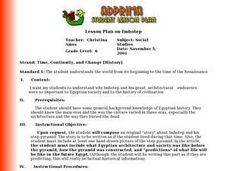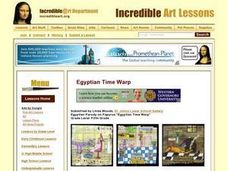Global Oneness Project
Clowning Around
Being a clown is hard work — no joke! Emmanuel Vaughan-Lee's Laugh Clown Laugh, a short film about German clown Reinhard "Filou" Harstkotte, asks viewers to consider the various roles played by clowns and to consider the implications of...
Curated OER
Portrait of a Ruler
Students create a full-length portrait of the Emperor Hadrian that conveys his role through attributes and explain how this bust of Hadrian conveys a story about life as an emperor in ancient Rome.
Curated OER
Using Evidence from a Shipwreck to Explore Late Bronze Age Trade in the Mediterranean
Students examine a shipwreck from the late Bronze Age. As a class, they view a variety of slides to describe the cargo and examine the artifacts found on the wreckage. They discuss what each object tells them about the crew and the time...
Curated OER
Tomb Interiors
Students explore tomb artwork, its placement, and its function in the afterlife.
Curated OER
Tombs and the Afterlife
Students design a tomb, create a model of it, and complete a short written assignment explaining the design and contents of the tomb. They study the concept of the afterlife and the importance of pleasing the gods and goddesses.
Curated OER
Mummies: Tales from the Egyptian Crypts Part IV
Young scholars choose one or two of the artifacts found in King Tutankhamen's tomb and describe and analyze the artifact. Explain what it tells us about Tutankhamen's life and about ancient Egyptian culture.
Curated OER
Nefertari: For Whom The Sun Shines
Students watch "Nefertari," which looks at the life of an Ancient Egyptian queen and the society she lived in. It also examines the issues archeologists face in preserving materials from the past.
Curated OER
Mini Coil Pots: Ceramics Lesson
Art is a wonderful way to teach historical or cultural concepts. Here, learners view a series of coil pots that have been created throughout history by a variety of civilizations. They then create and decorate a pot of their own that...
Curated OER
Imhotep
Sixth graders compose an original story about Imhotep and his step-pyramid. They also must include what Egyptian architecture and society was like before the pyramid, how the pyramid was constructed and predictions of what life will be...
Curated OER
Location of Cities 201
Students work in pairs to locate the ancient cities on a world atlas using the longitude and latitude measurements. They examine the physical and human futures that explain their locations.
Curated OER
Moses and the Ten Commandments
Students watch a video about Moses and the Ten Commandments; participate in discussion; create a replica table of the Ten Commandments, or create a picture illustrating the parting of the Red Sea.
Curated OER
The Rosetta Stone
Students examine the controversy surrounding the Rosetta Stone. In this Rosetta Stone lesson, students read an article about the stone and then follow the steps in the lesson to look at 2 sides of the controversy about it. The article is...
Curated OER
Egyptian Parody
Sixth graders investigate Egyptian art and draw themselves in an Egyptian pose.
Curated OER
Foundations of American Government
Fourth graders explore the origins of American government.
Curated OER
Slave Resistance in Natchez
Students examine various ways that slaves in the Natchez area resisted bondage, consider the price of resistance, and write television news documentary.
Curated OER
The History of Religion
Young scholars learn about the two main types of religions. In this religion lesson, students define religion and learn about early religion as well as religion in the west. Young scholars define animism, polytheism, pantheism,...
Curated OER
A Tour of Rome Fit for an Emperor
Learners travel to Rome. In this geography skills lesson, students explore famous places in Rome with Google Earth tools. Learners research the city of Rome and create touring brochures of the city from the perspectives of past emperors...
Curated OER
Exodus: History Writ Large
Students examine the history of the Exodus and life of Moses. In this Exodus lesson plan, students watch "Exodus: History Writ Large", research the life of Moses, and author books that depict scenes from Mose's life.
Curated OER
The Art of the Quilt
Students examine why fabric was first sewn in layers and how it was used. They identify, compare and make 3 different fabric design types which will become a basis for looking at the quilts created by African Americans. They begin the...
Curated OER
Hatshepsut's Temples and Obelisks
Third graders create Hatshepsut's Temples and Obelisks using a variety of materials.
Curated OER
The Eight Immortals
Students compare and contrast the Eight Immortals with American super-
heroes, such as Superman, Wonder Woman, and Aquaman while examining the literary genre of folktales and its connection to art.
Curated OER
Anasazi Basket Weaving: 0-500 A.D.
Sixth graders study Period 1- Basket Maker 0-500 A.D. of Anasazi Culture. They identify the sequence of history in Anasazi Culture and Indians of the Mesa Verde. They discover American Indian contributions to the world and develop...
Curated OER
Anasazi Pueblo Period: 700-1050 A.D.
Sixth graders study Period 3-Developmental Pueblo 700-1050 A.D., of Anasazi culture. They identify the sequence of history in Colorado and recognize American Indian Contributions to the world. They study Indians of the Mesa Verde and...
Curated OER
The Chinese Produce Paper as We Know it Today
Tenth graders explore where paper originated and its importance from the Chinese to the rest of the world. They list ten ways that they use paper on a daily basis and rate that use on a scale from one to ten. Each group also brainstorms...

























